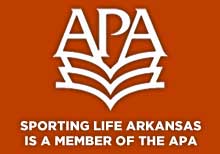WEST FORK – A low level of the fungus that causes white-nose syndrome in bats has been detected in two north Arkansas caves. The fungus was discovered in a cave at Devil’s Den State Park in Washington County and a private cave located in southern Baxter County. No bat deaths due to white-nose syndrome are known to have occurred in Arkansas.
The fungus was found in swab samples taken from hibernating bats in February 2012 and January 2013. Tests detected DNA that indicates the fungus (Geomyces destructans) that causes white-nose syndrome, which is deadly for bats, particularly in the northeastern U.S. and Canada. The testing was part of a national study funded by the National Science Foundation and led by researchers at University of California Santa Cruz and Northern Arizona University to track the spread of the disease.
One swab from the wall of Devil’s Den Cave was found to be positive with a low level of the fungus detected. A total of five swabs from bats and two swabs from the cave wall at the private cave were positive for the fungus. The samples from the private cave were taken in 2012 and were originally thought not to have the fungus, but were reanalyzed using a more sensitive technique this year and the fungus was identified. The characteristic white nose seen on bats with the fungus on them was not present on these surveys and the fungus was only present in microscopic amounts.
In April 2010, Devil’s Den Cave and Ice Box Cave at Devil’s Den State Park, and War Eagle Cave at Withrow Springs State Park, were closed to the public by Arkansas State Parks as precautions to protect the caves from the possibility of contamination from white-nose syndrome. Earlier, in May 2009, Farmer’s Cave and Big Ear Cave at Devil’s Den closed as precautionary measures.
State Parks Director Greg Butts said, “Safeguarding natural resources is an integral part of Arkansas State Parks’ mission. We know the public understands why we’re working with other state and federal agencies to do all we can to protect Arkansas’s caves and the bat species that inhabit them.”
Blake Sasse, the Arkansas Game and Fish Commission’s Nongame Mammal Program Leader said the agency would be watching the caves closely. “We’ll be returning to these sites this winter to see if the fungus has caused the development of white-nose syndrome and will be surveying caves near them to track its spread,” Sasse said.
In March 2010, the AGFC closed all caves on AGFC land and Arkansas Natural Heritage Commission natural areas/wildlife management areas to prevent the spread of white-nose syndrome. The AGFC owns at least 83 caves on four WMAs in Arkansas. The four AGFC areas that contain caves are McIlroy Madison County, Gene Rush, Loafer’s Glory and Harold E. Alexander WMAs.
White-nose syndrome is thought to be transmitted primarily from bat to bat or substrate to bat, but fungal spores may be inadvertently carried to caves by humans on clothing and caving gear. The syndrome is not known to pose a threat to humans, pets or livestock.
Bats with WNS may exhibit unusual behavior during cold winter months, including flying outside during the day and clustering near the entrances of caves and mines where they hibernate. Bats have been found sick and dying in unprecedented numbers near affected sites. Bats play a key role in keeping insects, including agricultural pests, mosquitoes and forest pests, under control.
The disease is associated with massive bat mortality in the northeastern and mid-Atlantic United States. Since the winter of 2006-07, bat population declines ranging from 80 percent to 97 percent have been documented at surveyed hibernation areas that have been most severely affected. Although exact numbers are difficult to determine, biologists estimate that losses may exceed five million bats since 2007.
The public can help several of the species that are known to be impacted by white-nose syndrome by building bat houses on their property. They can be obtained commercially from many sources or they can be built by using plans available on the AGFC’s website at www.agfc.com/resources/Publications/building_bat_houses.pdf.
While Blanchard Springs Caverns near Mountain View remains open, all other caves on the Ozark National Forest were closed in 2009. Decontamination procedures were set in place at Blanchard Springs Caverns at that time as recommended by the U.S. Fish and Wildlife Service. These procedures include a pre-screening questionnaire for cave visitors, decontamination measures for visitors having visited a cave in a state positive for white-nose syndrome, and limits on items that can be carried into the cave.
“We believe involving the public in stemming the spread of this disease is an important part of what we’re doing at Blanchard Springs Caverns,” said Jim McCoy, District Ranger responsible for management of the popular destination. “Bats play a key role in keeping insects, including agricultural pests, mosquitoes and forest pests, under control. When people tour the caverns and see that bats have gotten a bad rap, they become a champion for their survival, and right now, bats need all the champions they can get.”
The AGFC encourages owners of caves on private lands to also close their caves to public access in order to protect bats. Cave explorers should check with land owners and property managers to check status before visiting any cave. All cave visitors should decontaminate clothing, footwear and equipment before and after cave visits, following national WNS decontamination protocols. The most up-to-date protocols can be found here: http://whitenosesyndrome.org/topics/decontamination.
The ongoing efforts of the AGFC and its partners symbolize collaborative preparation for and response to WNS by agencies and researchers, said Dr. Jeremy Coleman, national white-nose syndrome coordinator for the U.S. Fish and Wildlife Service. “This discovery of the fungus in Arkansas, while not unanticipated, is an important contribution to the international effort to understand and manage the spread of this disease and its impact on bats,” Coleman said.
Additional information on white nose syndrome and bats is available at www.whitenosesyndrome.org. For photos, go to: http://www.flickr.com/photos/usfwshq/collections/72157626455036388/.
Courtesy Arkansas Game and Fish Commission












